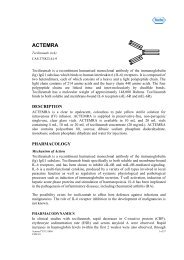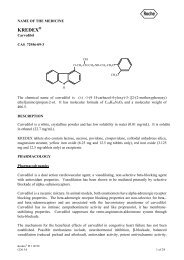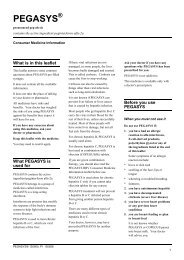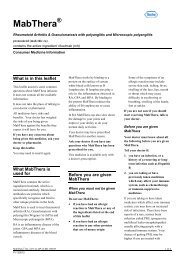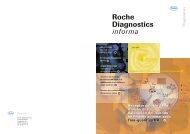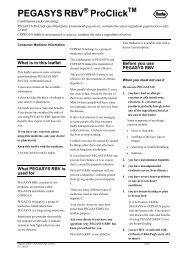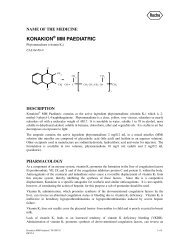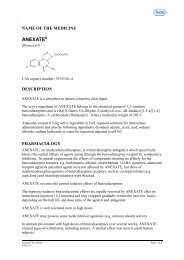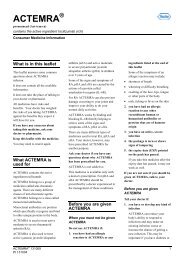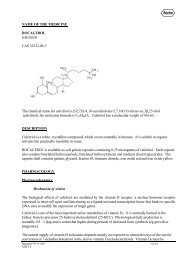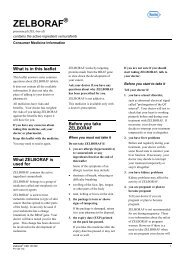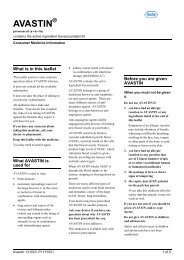Product Information PI - Roche Australia
Product Information PI - Roche Australia
Product Information PI - Roche Australia
You also want an ePaper? Increase the reach of your titles
YUMPU automatically turns print PDFs into web optimized ePapers that Google loves.
A second study was conducted in 334 asthmatic children aged 6 – 12 years of age, 53.6% of<br />
whom were influenza-positive. The median time to freedom from illness was reduced by 8%<br />
in patients treated with TAMIFLU compared to placebo (not statistically significant). By day<br />
6 (the last day of treatment) FEV 1 had increased by 10.8% in the TAMIFLU-treated group<br />
compared to 4.7% in the placebo group (p = 0.0148) although there was no difference in the<br />
use of asthma medication between groups.<br />
Prevention of Influenza in Infants and Children – Study WV16193<br />
The efficacy of oseltamivir in preventing naturally occurring influenza illness has been<br />
demonstrated in a post-exposure prevention study in households that included adults,<br />
adolescents, children and infants aged 1 – 12 years old, both as index cases and as family<br />
contacts. The primary efficacy parameter for this study was the incidence of laboratoryconfirmed<br />
clinical influenza in the households. Oseltamivir prophylaxis lasted for 10 days<br />
(prophylactic efficacy in adults and adolescents ‡ 13 years old has previously been<br />
demonstrated with a 7 day dosing regimen [see above]).<br />
In the total population, there was a reduction in the incidence of laboratory-confirmed clinical<br />
influenza in households from 20% (27/136) in the group not receiving prevention to 7%<br />
(10/135) in the group receiving prevention (62.7% reduction, [95% CI 26.0 - 81.2]; p =<br />
0.0042). In households of influenza-infected index cases, there was a reduction in the<br />
incidence of influenza from 26% (23/89) in the group not receiving prevention to 11% (9/84)<br />
in the group receiving prevention (58.5% reduction, [95% CI 15.6 - 79.6]; p = 0.0114).<br />
According to subgroup analysis in children 1 – 12 years of age, the incidence of laboratoryconfirmed<br />
clinical influenza among children was significantly reduced from 19% (21/111) in<br />
the group not receiving prevention to 7 % (7/104) in the group receiving (64.4% reduction,<br />
[95% CI 15.8 - 85.0]; p = 0.01; ITT). Among children who were not already shedding virus<br />
at baseline, the incidence of laboratory-confirmed clinical influenza was reduced from 21%<br />
(15/70) in the group not receiving prevention to 4% (2/47) in the group receiving prevention<br />
(80.1% reduction, [95% CI 22.0 - 94.9]; p = 0.0206; ITTIINAB) (see Table 4).<br />
Table 4: Incidence of Influenza Infection among Paediatric Contacts<br />
Population<br />
Number<br />
of<br />
Contacts<br />
1-12 years<br />
Influenza-infected Contacts<br />
P T Total<br />
Index<br />
Case<br />
Infected<br />
%<br />
Protective<br />
efficacy of<br />
oseltamivir<br />
p-value<br />
Overall ITT 215 7 (7%) 21 (19%) 28 24 64.4 0.01<br />
ITTII 129 6 (11%) 18 (24%) 24 24 55.2 0.089<br />
ITTIINAB 117 2 (4%) 15 (24%) 17 24 80.1 0.0206<br />
P = prophylaxis<br />
T = treatment<br />
ITTII = intent-to-treat index-infected<br />
ITTIINAB = intent-to-treat index-infected, not infected at baseline.<br />
Tamiflu <strong>PI</strong> 6 mg/mL oral suspension and capsules 120119 10 of 28<br />
CDS 10.0



